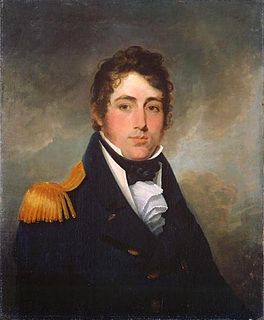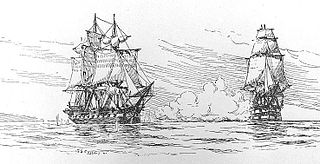Related Research Articles

Oliver Hazard Perry was an American naval commander, born in South Kingstown, Rhode Island. As the best-known and most prominent member of the Perry family naval dynasty, he was the son of Sarah Wallace Alexander and United States Navy Captain Christopher Raymond Perry, and older brother of Commodore Matthew C. Perry.

Admiral of the Fleet Sir Provo William Parry Wallis, was a Royal Navy officer. As a junior officer, following the capture of USS Chesapeake by the frigate HMS Shannon during the War of 1812, the wounding of HMS Shannon's captain and the death of her first lieutenant in the action, he served as the temporary captain of HMS Shannon for a period of exactly six days as she made her way back to Halifax, Nova Scotia, with Chesapeake flying the Blue Ensign above the Stars and Stripes.

Isaac Hull was a Commodore in the United States Navy. He commanded several famous U.S. naval warships including USS Constitution and saw service in the undeclared naval Quasi War with the revolutionary French Republic (France) 1796–1800; the Barbary Wars, with the Barbary states in North Africa; and the War of 1812 (1812–1815), for the second time with Great Britain. In the latter part of his career he was Commandant of the Washington Navy Yard in the national capital of Washington, D.C., and later the Commodore of the Mediterranean Squadron. For the infant U.S. Navy, the battle of USS Constitution vs HMS Guerriere on August 19, 1812, at the beginning of the war, was the most important single ship action of the War of 1812 and one that made Isaac Hull a national hero.

The Fortune of War is the sixth historical novel in the Aubrey-Maturin series by British author Patrick O'Brian, first published in 1979. It is set during the War of 1812.

Master Commandant William Henry Allen was an American naval officer during the War of 1812.

Chesapeake was a 38-gun wooden-hulled, three-masted heavy frigate of the United States Navy. She was one of the original six frigates whose construction was authorized by the Naval Act of 1794. Joshua Humphreys designed these frigates to be the young navy's capital ships. Chesapeake was originally designed as a 44-gun frigate, but construction delays, material shortages and budget problems caused builder Josiah Fox to alter her design to 38 guns. Launched at the Gosport Navy Yard on 2 December 1799, Chesapeake began her career during the Quasi-War with France and later saw service in the First Barbary War.

Melancthon Taylor Woolsey was an officer in the United States Navy during the War of 1812 and battles on the Great Lakes. He supervised warship construction at Navy Point in Sackets Harbor, New York, and later had a full career in the Navy.

James Lawrence was an American naval officer. During the War of 1812, he commanded USS Chesapeake in a single-ship action against HMS Shannon commanded by Philip Broke. He is probably best known today for his last words or "dying command" "Don't give up the ship!", which is still a popular naval battle cry, and which was invoked by Oliver Hazard Perry's personal battle flag, adopted to commemorate his dead friend.
John Joliffe Yarnall (1786–1815) was an officer in the United States Navy during the War of 1812 and the Second Barbary War.
Joseph Tarbell was an officer in the United States Navy during the First Barbary War and the War of 1812.
Augustus C. Ludlow was an officer in the United States Navy during the War of 1812.
Lieutenant Fitz Henry Babbitt was an officer of the United States Navy who served during the War of 1812, and was killed during the capture of USS President.

Sir Philip Bowes Vere Broke, 1st Baronet was a distinguished officer in the British Royal Navy. During his lifetime he was often referred to as Broke of the Shannon, a reference to his notable command of HMS Shannon in the War of 1812. His most famous military achievement was defeating and capturing the American frigate, USS Chesapeake.

HMS Shannon was a 38-gun Leda-class frigate of the Royal Navy. She was launched in 1806 and served in the Napoleonic Wars and the War of 1812. She won a noteworthy naval victory on 1 June 1813, during the latter conflict, when she captured the United States Navy frigate USS Chesapeake in a singularly bloody battle.

The sinking of HMS Peacock was a naval action fought off the mouth of the Demerara River, Guyana on 24 February 1813, between the sloop of war USS Hornet and the Cruizer-class brig-sloop HMS Peacock. After an exchange of broadsides, Hornet was able to rake Peacock, forcing her to strike. Peacock was so badly damaged that she sank shortly after surrendering.

The Capture of USS Chesapeake, also known as the Battle of Boston Harbor, was fought on 1 June 1813, between the Royal Navy frigate HMS Shannon and American frigate USS Chesapeake, as part of the War of 1812 between the United States and Great Britain. The Chesapeake was captured in a brief but intense action in which 71 men were killed. This was the only frigate action of the war in which there was no preponderance of force on either side.

The Battle of Valparaíso, also called the Capture of USS Essex, was a naval action fought during the War of 1812. It took place off Valparaíso, Chile on March 28, 1814 between the frigate USS Essex and the sloop USS Essex Junior of the United States Navy and the frigate HMS Phoebe and sloop HMS Cherub of the Royal Navy. The British ships won the battle, and the American vessels were captured.

William Sitgreaves Cox (1790–1874) was an American sailor during the War of 1812. He was serving as acting lieutenant aboard the USS Chesapeake at the time of its capture by HMS Shannon. Cox was subsequently court-martialed for his actions during that engagement and discharged from the Navy. After advocacy from his descendants, his rank was restored by President Harry S Truman.

The Chesapeake–Leopard affair was a naval engagement that occurred off the coast of Norfolk, Virginia, on Monday, June 22, 1807, between the British warship HMS Leopard and the American frigate USS Chesapeake. The crew of Leopard pursued, attacked, and boarded the American frigate, looking for deserters from the Royal Navy. Chesapeake was caught unprepared and after a short battle involving broadsides received from Leopard, the commander of Chesapeake, James Barron, surrendered his vessel to the British. Chesapeake had fired only one shot.

The Royal Navy Burying Ground is part of the Naval Museum of Halifax and was the Naval Hospital cemetery for the North America and West Indies Station at Halifax, Nova Scotia. It is the oldest military burial ground in Canada. The cemetery has grave markers to those who died while serving at Halifax and were treated at the Naval medical facility or died at sea. Often shipmates and officers had the grave markers erected to mark the deaths of the crew members who died while in the port of Halifax.
References
- This article incorporates text from the public domain Dictionary of American Naval Fighting Ships .